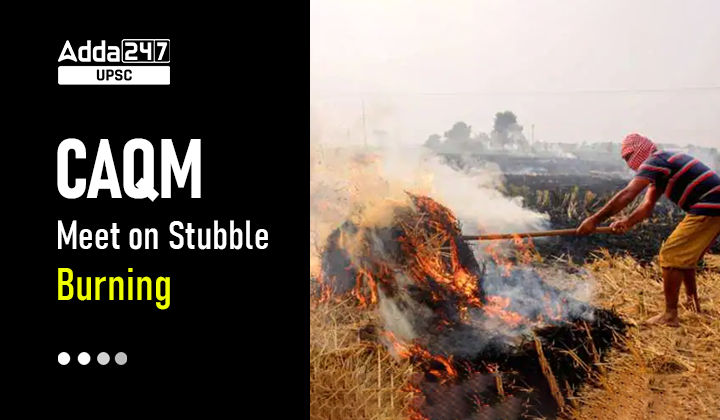Table of Contents
CAQM Meet on Stubble Burning- Why important for UPSC Exam
CAQM Meet on Stubble Burning: Commission for Air Quality Management in NCR and Adjoining areas is an important body for controlling pollution in the Delhi-NCR Region. Commission for Air Quality Management in NCR and Adjoining areas is relevant for UPSC Prelims Exam (Environment) and UPSC Mains GS Paper 3 (Environment: Conservation, environmental pollution and degradation).
CAQM Meet on Stubble Burning in News
- Commission for Air Quality Management in NCR and Adjoining areas has recently held review meetings to address stubble burning.
- Commission for Air Quality Management in NCR and Adjoining areas has issued Statutory Directions for implementation of the State Specific Action Plan.
- This comes in the light of increased incidents of stubble burning in Punjab this year.
CAQM on Stubble Burning
- As per the satellite remote sensing data, up to 24/10/2022, only about 39% of sown area in Punjab had been harvested and thus rising number of fire events is a matter of concern.
- As per the Standard Protocol developed by ISRO for CAQM, for the period 15thSeptember, 2022 to 26th October, 2022, total paddy residue burning events reported in Punjab are 7,036 compared to 6,463 for the same period during the last year.
- CAQM further stated that about 70 % of farm fires during the current paddy harvesting season were reported only from six districts namely Amritsar, Firozpur, Gurdaspur, Kapurthala, Patiala and Tarn Taran.
- These Districts account for 4,899 cases as against a total of 7,036 incidents in Punjab.
- These traditional six hotspot Districts had also accounted for about 65% of the total burning incidents during the last year for the same period.
Major Pillars of CAQM Comprehensive Action Plan for Punjab
- Diversification to other crops, diversification to low straw generating and early maturing paddy varieties;
- In-situ crop residue management including bio-decomposer application;
- Ex-situ crop residue management;
- IEC activities;
- Monitoring and effective enforcement.
Steps taken in CAQM meeting 2022
Key areas and action points stressed upon during the meetings were:
- Speedy procurement of additional farm machinery through fund allocations made by MoAFW under the Crop Residue Management (CRM) Scheme during 2022-23.
- Mapping of available machinery in Custom Hiring Centres and cooperatives.
- Optimised use of available CRM machinery including staggering harvesting schedule at village/ cluster level.
- Expanding bio-decomposer application to supplement in-situstubble management measures.
- Facilitating robust supply chain towards ex-situ
- Intensifying campaigns and IEC activities against stubble burning.
- Intensifying monitoring and enforcement actions.
Commission for Air Quality Management in NCR and Adjoining Areas- Key Points
- About: The Commission for Air Quality Management (CAQM) is a statutory body formed under the Commission for Air Quality Management in National Capital Region and Adjoining Areas, Act 2021.
- Earlier, the commission was formed through the promulgation of the Commission for Air Quality Management in National Capital Region and Adjoining Areas Ordinance, 2021.
- The Commission for Air Quality Management in National Capital Region and Adjoining Areas, Act 2021 also dissolved the Environment Pollution Prevention and Control Authority (EPCA) established in the NCR in 1998.
- Mandate: To ensure better coordination, research, identification and resolution of problems surrounding the air quality index and for matters connected therewith or incidental thereto.
- Scope: Adjoining areas have been defined as areas in the states of Haryana, Punjab, Rajasthan, and Uttar Pradesh adjoining the NCR where any source of pollution may cause an adverse impact on air quality in the NCR.
- Composition: The Commission for Air Quality Management in NCR and Adjoining Areas will consist of:
-
- A Chairperson,
- An officer of the rank of a Joint Secretary as the member-secretary and Chief Coordinating Officer,
- A currently serving or former Joint Secretary from the central government as a full-time member,
- Three independent technical members with expertise related to air pollution, and
- Three members from non-government organizations.
- The Commission will also include ex-officio members:
- From the central government and concerned state governments, and
- Technical members from CPCB, Indian Space Research Organisation, and NITI Aayog.
- May also appoint representatives of certain ministries.
- Tenure: The Chairperson and members of the Commission will have a tenure of three years or till the age of seventy years, whichever is earlier.
- Selection Committee for appointment: will be constituted by the central government for recommending appointments of members of the Commission. The Committee will include-\
- Chairperson- Minister in charge of the Ministry of Environment, Forest and Climate Change.
- Members of the Committee will include–
- Minister of Commerce and Industry,
- Minister of Road Transport and Highways,
- Minister of Science and Technology, and
- Cabinet Secretary.
- Sub-Committees: The Commission for Air Quality Management in NCR and Adjoining Areas is required to form sub-committees on-
- Monitoring and identification headed by a Member of the Commission.
- Safeguarding and enforcement headed by the Chairperson of the Commission and
- Research and development headed by a technical member of the commission.
Commission for Air Quality Management in NCR and Adjoining Areas
Commission for Air Quality Management in NCR and Adjoining Areas



 TSPSC Group 1 Question Paper 2024, Downl...
TSPSC Group 1 Question Paper 2024, Downl...
 TSPSC Group 1 Answer key 2024 Out, Downl...
TSPSC Group 1 Answer key 2024 Out, Downl...
 UPSC Prelims 2024 Question Paper, Downlo...
UPSC Prelims 2024 Question Paper, Downlo...





